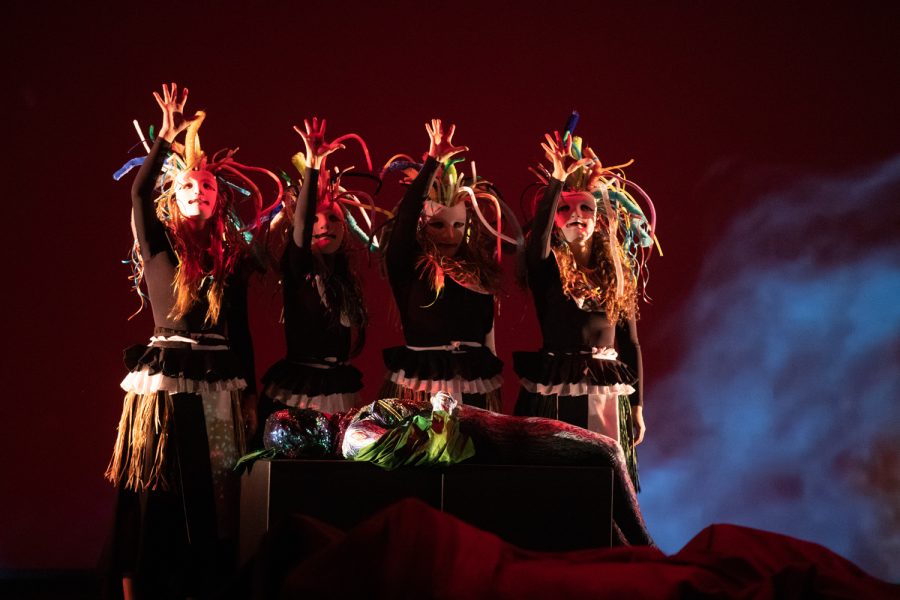UI Dance Company Home Concert showcases themes of planet betterment
The University of Iowa Department of Dance held its annual home concert on Feb. 23-25. Messages of climate change and planet betterment were integral to the performances, alongside live music and meaningful costumes.
Dancers perform during a dress rehearsal for the UI Dance Company’s Home Concert at Space Place Theater on Wednesday, Feb. 23, 2023.
February 28, 2023
Two dances by the University of Iowa Dance Company left the audience inspired and curious through stellar storytelling from choreographers and dancers.
The dance company performed its annual Home Concert at Space Place Theater in North Hall from Feb. 23-25. Choreographer and assistant professor of contemporary dance at the UI, Melinda Jean Myers, said the performance was centered around climate change and sparking conversation about how people can find creative ways to help.
“The objective originally was to talk about climate change, trying to understand it on deeper levels, and how art practice and creativity is something that can be both used as a vehicle for learning about what humans can do better and then also as a place of expressing experience of this time,” Myers said.
Myers said the dancers and choreographers collaborated in the fall to build relationships between the dance company and the community.
They also partnered with several outside groups, including the UI’s Environmental Coalition and The LENA Project, an Iowa City-based nonprofit focused on instigating environmental change.
“We talked with the Environment Coalition, which is a student organization on campus in the Office of Sustainability, and wanted to partner with them around actions for the betterment of climate change and planet-based collective action,” Myers said.
The first piece performed in the show’s lineup was “The Legend of the Pitch Lake Myth,” which was a narrative dance centered around human greed and consumption. It was choreographed by Grant Wood Fellow Kieron Dwayne Sargeant.
According to the Department of Dance’s website, the dance is “centered around one of the legendary myths of the Pitch Lake in Trinidad and Tobago,” which Sargeant visited in October 2022. The myth tells the story of a “great feast of hummingbirds” and how the Pitch Lake — a real lake of asphalt in southwest Trinidad — swallowed a village whole.
Myers said the dance’s purpose was to point out the lack of self-awareness many people have when it comes to respecting nature and the planet.
“It’s about people taking things that are not theirs or taking too much — over-consuming, not paying attention, or paying attention to the wrong things,” Myers said. “Not prioritizing the planet, not prioritizing nature, and not prioritizing ourselves into the best of our health and our wholeness.”
The second performance, “Right Here,” was choreographed by Myers with assistance from Todd Rhodes, the teaching assistant for the dance company and assistant director. Dance students also collaborated with Myers for the performance. Myers said the piece explores the different shades of the human experience and humanity’s impact on the planet.
RELATED: UI Department of Dance’s ‘Graduate/Undergraduate Concert’ returns in-person
“It became very clear to me that I didn’t want to make a dance about climate change because I don’t think that necessarily would have done as much visually and expressly as actually centering around human experiences of systems: social systems, economic systems, systems of power and hierarchy — reasons that fuel why climate change is such a problem,” Myers said.
Using costume changes and props like plastic bags and lights were both elements in the dance that brought awareness to climate change and action.
“Right Here” was also a collaboration with Lex Leto, a composer who created the music for the piece. Leto performed with their electric guitar and recording tools in each show alongside the dancers to create an exciting, lively experience for the audience.
“Their music is coming from an original collaboration, which is so exciting because, typically, when folks make dance, music has already been created, and then the dance is made to the music,” Myers said.
The choreography also included plastic bag trench coats made by Jay Hough, the guest costume designer for the concert. Myers said the department collected thousands of plastic grocery bags for the costumes.
“The company did a plastic bag drive in our department,” Myers said. “Students of the department brought all their plastic bags from retail stores.”
At the end of “Right Here,” potted plants were brought on stage as a homage to the earth and growth. Audience members had the option to purchase a plant from the stage after the show.
As a takeaway, Myers said attendees should take time for self-reflection.
“We should be thinking about who we are as people and who we want to be, both on an individual level and, even more importantly, as a community,” Myers said.



